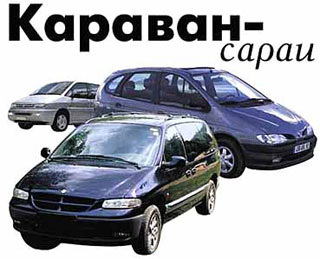Test drive Chrysler Voyager 1999 - 2000
Voyage from the city to the village
 What is a minivan? Why are they so loved in Europe and in the USA?
What is a minivan? Why are they so loved in Europe and in the USA? A brief encyclopedia is based on Chrysler Voyager Se and Chrysler Town & Country Limited
The word minivan, as a definition of the type of car body, in our country stubbornly does not want to take root. In the best case, these machines are called minibuses, in the worst - Rafiks, in memory of the products of the Latvian auto industry.
Holy place. After the conquest of the Latvian people of political independence, the Raf's automobile plant quietly died. The scene was empty for a good ten years, and then in the smoke of irreparable gases a Rafik on the basis of the Gazelle proudly rolled out on it. Unfortunately, the designers of the Gazovsky Minivan were under the strong hypnosis of the past - all the same sold seats and glass, fogged from the stray breathing of ten passengers. The trend of the new time is only that passengers of the Rafiks paid 10 kopecks, and passengers of gazelles pay four rubles today.
Meanwhile, the development of technical thought in the West brought the design of the minivans to perfection. Moreover, the United States and Europe play according to different rules, observing only the laws of the genre. And Chrysler produces even two versions of the same Voyager model: under the name Town & Country - only for the United States and under its own - for Europe.
Son and stepson. First of all, the difference in the design of the front of the car is striking. Town & Country is decorated in a modern Chrysler style and carries family lhs or 300m family features. Voyager is more conservative and clearly loses to the American in terms of design. It is not entirely clear why Chrysler retained the outdated design after the deafening success of the same LHS in the European market. If you do not focus on the difference in the design of the front headlights and rear lights, which is explained by differences in European and American GOSTs, then this is the only significant difference in external design.
The presence of side glasses in the American version and the absence of the same on European can again be explained by a different approach to road safety. In sunny California, this is good, and in Finland, for example, is not welcomed by representatives of the traffic police.
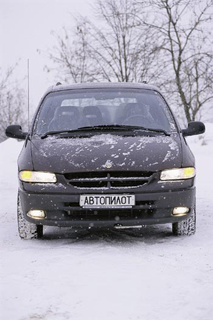 WHO IS COOLER? Inside, both cars are organized in accordance with the same laws of the genre, but with amendments to the consumer mentality. In the American version, a richer interior decoration is immediately striking. The Americans love external shine, and nothing can be done here. The leather upholstery of all seats, more expensive in appearance and to the touch wooden inserts, and few islands of fabric upholstery are more soundly made. Europeans are content with combined fabric trim and a more modest wooden inlay.
WHO IS COOLER? Inside, both cars are organized in accordance with the same laws of the genre, but with amendments to the consumer mentality. In the American version, a richer interior decoration is immediately striking. The Americans love external shine, and nothing can be done here. The leather upholstery of all seats, more expensive in appearance and to the touch wooden inserts, and few islands of fabric upholstery are more soundly made. Europeans are content with combined fabric trim and a more modest wooden inlay. Americans by nature are bar. The middle series of seats in Town & Country is made in the form of two separate chairs with a rather significant cargo space in the middle. Moreover, in a folded state, the back of each chair is a table for gifts from McDonald's with mandatory stamping for glasses from diet-Coca. Under each armchair is a pen that allows literally in one movement to free it from attachment to the floor and turn the minivan into a huge limousine. The sizes of the side shift doors, by the way, allow you to do this with a minimum of physical costs.
In Voyager, the middle row of seats is made in the form of a whole sofa, also removable. But a similar procedure for turning the bus into limousine is associated in the European version with significant physical efforts, and all interested family members should be thrown on it.
In addition, the Americans feel much more Volga -Mennaya on the back sofa. Town & Country is 340 mm longer than Voyager, and therefore the sofa in it is located in a wider part of the body. An extra ten millimeters, firstly, allows three adults to calmly relax, stretching long legs in a cowboy boots. Secondly, the trunk has become much more spacious, and, for example, three saddles for riding will be freely accommodated in it to justify the presence of cowboy boots. But the curtain is not provided - obviously, in America they steal less often than in Europe.
No smoking. This, of course, is a trifle, but a trifle is indicative. There is no cigarette lighter in Town & Country. That is, of course, there is a nest, but it is covered with a massive rubber lid with a 12V inscription. In its fight against smoking, America sometimes reaches absurd!
By the way, this is almost the only difference in the internal bells and whistles. Both machines are equipped with a full electric packet, an on-board triple-computer, cruise control, air conditioning system and an audio system. For Europe with a developed FM broadcast system, the Eon-RDS function is provided in the radio.
We found an interesting device on the steering column Voyager. Obviously, this is a rudimentary idea of \u200b\u200bthe Americans about the old light with narrow medieval streets - a special switch can be folded from the driver's seat and open the side mirrors.
Plants of control lamp blocks are organized quite original on both models. Indicators of additional equipment - ABS, open -door indicator, engine service alarm and airbags - light up at the time of starting the engine in the usual place in a combination of devices. The remaining indicators - turn signals, oil pressure, etc. - are grouped in a narrow gap above the visor of the instrument panel. The solution is quite original and, it seems, correct. The sunbathing of a particular light bulb located at the very bottom of the dashboard can not be seen with intense movement not immediately, and in Chrysler the most important indicators are located in the windshield area, i.e. Before the eyes of the driver.
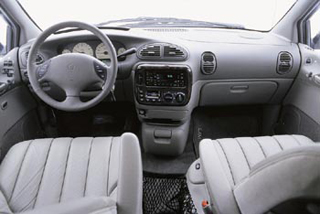 Automatic equalization. The differences in the decoration and service equipment can be attributed to the difference in the configuration - Town & Country was packaged in the luxury class. The main thing that is the difference between an American and a European is, first of all, an engine. Buying a car, both an American and a European ask the same question: how many liters? Only one has in mind the volume of the engine, and the other - fuel consumption per hundred kilometers. Based on this, Town & Country has a beloved e-shaped six-cylinder engine with a volume of 3.8 liters beloved on the other side of the ocean. On Voyager - four 2.4 liters.
Automatic equalization. The differences in the decoration and service equipment can be attributed to the difference in the configuration - Town & Country was packaged in the luxury class. The main thing that is the difference between an American and a European is, first of all, an engine. Buying a car, both an American and a European ask the same question: how many liters? Only one has in mind the volume of the engine, and the other - fuel consumption per hundred kilometers. Based on this, Town & Country has a beloved e-shaped six-cylinder engine with a volume of 3.8 liters beloved on the other side of the ocean. On Voyager - four 2.4 liters. And here the most interesting begins. The same four -speed automatic gearbox is installed on both cars. A higher -cost European engine practically negates the presence of extra 33 horses in the American version. At least in the city ride. Both cars are accelerated the same, and all attempts to compete during our test drive on a straight line have not led to anything. In the sense that a clear champion could not be determined. Both machines are accelerated equally evenly and powerfully and gain 60 km/h perceptions in the city in a few seconds. A significant difference is only in the smoothness of the course. Despite the spring suspension behind (also a tribute to American fashion), the long -stand Town & Country moves much more smoothly along the Russian pavement far from perfection.
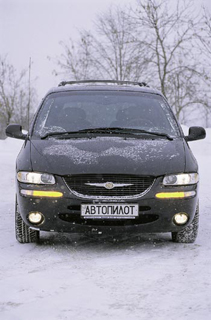 Two against four. The obvious advantage of the American version (but not an American lifestyle) is the presence of permanent all -wheel drive on Town & Country. The center differential with the WISKOFTA precisely doses the traction force between the front and rear wheels, depending on the road environment. As a result, firstly, it practically eliminates the slipping of the wheels and drifts at a sharp start from the traffic light. Secondly, Town & Country is much more stable in sharp turns, if you go at speeds above 60 km/h and on a rather slippery road, as it was on the day of our test drive. The driver of Voyager, who was constantly holding the bumper in the bumper, complained that he did not feel very confident if, when leaving the turn, I wanted to give a gasket on a road covered with a light snowball at the side of the road.
Two against four. The obvious advantage of the American version (but not an American lifestyle) is the presence of permanent all -wheel drive on Town & Country. The center differential with the WISKOFTA precisely doses the traction force between the front and rear wheels, depending on the road environment. As a result, firstly, it practically eliminates the slipping of the wheels and drifts at a sharp start from the traffic light. Secondly, Town & Country is much more stable in sharp turns, if you go at speeds above 60 km/h and on a rather slippery road, as it was on the day of our test drive. The driver of Voyager, who was constantly holding the bumper in the bumper, complained that he did not feel very confident if, when leaving the turn, I wanted to give a gasket on a road covered with a light snowball at the side of the road. Third and most importantly. Our photo artist, obsessed with a mania of high art, drove both minivan on snow virgin lands. The depth of snow was non -commercial - 15-20 cm, but Voyager sat there tightly. In fairness, we note that both cars were shod in standard highway rubber, even without marking M+S. So, Voyager simply twisted the front wheels in one place, rolling snow in bare ice in a few seconds. And we were able to break out only when three human ones were added to horsepower.
But the behavior of Town & Country was beyond praise. With light yuz in the most slippery areas, rearing behind him a cloud of snow, he not only easily overcame the snow target, but also jumped over a rather impressive snowdrift, swept over the side of the Cooperation of the capital from the snow.
Autopilot thanks the company Major Auto, (095) 492-4607, 497-6840, for cars provided for test. For the period of the test, the cars were insured in the company RESO-Garantia, (095) 250-3600, 255-6834.
Model/Modification Chrysler Voyager Se Chrysler Town & Country Limited
Daimlerchrysler manufacturer
The country-producing USA
BODY
Type minivan minivan
Number of doors/places 5/7 5/7
ENGINE
Gasoline type with electronic injection gasoline with electronic injection
The location in front is transversely
Working volume (cubic cub) 2429 3778
Number/location of cylinders 4/rowing 6/V-shaped
The diameter of the cylinder x Piston stroke (mm) 87.5x101.0 96.0x87.0
Compression degree 9.4: 1 9.0: 1
Power, kW (L.S.) at about./Min. 110 (150) at 5250 134 (183) at 4400
Moment (nm at about./Min.) 229 at 4000 325 at 3150
The number of valves
on cylinder 4 2
TRANSMISSION
The front wheel drive, the self -locking differential of the rear axle is constant full, intericental differential with viscousyft
Gearbox automatic, four -speed
SUSPENSION
Front spring, triangular transverse levers, stabilizer of the transverse stability
The rear spring, independent wheels suspension, the traction of Panar is a spring, an uncertain beam of the bridge, Panar's thrust, by order - a reptile stabilizer
STEERING
Type gear rack with hydraulicity
The diameter of the turn (m) 11.5 12.0
Brakes
Front disk ventilated
The rear drum
ABS is three -channel
Wheels
Tire size 215/65 R15 215/65 R16
6J, 6.5j, alloy
Dimensions/Opam/Weight
Length/width/height (mm) 4730/1920/1790 5070/1920/1790
Wheel base (mm) 2880 3030
The track front/back (mm) 1600/1630
Clearance (mm) 130 140
Trunk volume (L) 450/4140 670/4880
Equipped mass (kg) 1760 1810
Dynamic characteristics
Maximum speed (km/h) 180 over 170
Acceleration from 0 to 100 km/h (sec.) 12 12
Economy
Fuel consumption (l/100 km):
Highway 8.3 9.8
City cycle 14.2 13.8
Price in Moscow $ 35,000 $ 49,000
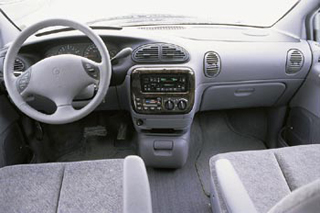 And who else is Ivan Ottigaev, the director of a private security agency: we needed a very roomy, but at the same time powerful, high -speed and maneuverable car on Town & Country, the choice fell by no means by chance. Often you have to accompany customers with large amounts or simultaneously transport a large group of employees. A full -wheel drive minivan seemed more convenient to me than a traditional jeep, but we do not ride on the fields. They rolled over 100 thousand kilometers, there were no serious breakdowns.
And who else is Ivan Ottigaev, the director of a private security agency: we needed a very roomy, but at the same time powerful, high -speed and maneuverable car on Town & Country, the choice fell by no means by chance. Often you have to accompany customers with large amounts or simultaneously transport a large group of employees. A full -wheel drive minivan seemed more convenient to me than a traditional jeep, but we do not ride on the fields. They rolled over 100 thousand kilometers, there were no serious breakdowns. Vasily Levitsky, Director of the Center for Informatics: The minivan for me was a pink dream of youth, in fact, this is the second car in the family and I use it mainly in the summer, I like to travel by car in a good company. I have been driving for more than 20 years, I tried many cars. I like Voyager, first of all, in it, as they say, is a table and a house, and traveling on it is no more difficult than on a simple passenger car. True, gasoline loves to eat, but how much pleasure and benefit.
Paul Clapper, manager of the Russian-Gollandic company: for us, such a car is not a whim, but an urgent need for an occupation we have to go to Russian cities and neighboring countries. Voyager is almost perfect, just an office on wheels. That's just the Chrysler service in your country is weak, almost everything has to be done in Finland.
Text Nikolay Kachurin, photo Dmitry Novokreshhenov
A source: "Autopilot"


